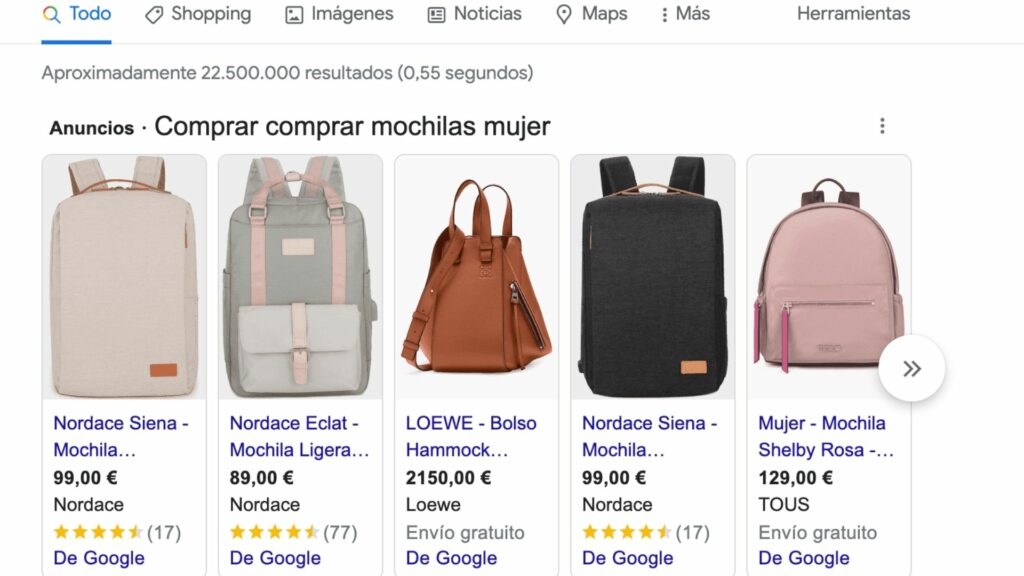Surely you wonder what SEM positioning is or what you can achieve with it. Well, the first thing you should understand is that it is not an organic positioning as such, but a payment one.
You can work through different platforms, but, what is clear, is that SEM positioning helps you both to increase the traffic of your website and to increase sales and conversions in a more direct way.
At Kiwop we want your business to be future. That is why we recommend you continue reading this article about the definitive guide to learn everything about SEM positioning.
What are you waiting for?
The first thing you should know is, of course, what SEM is. The simplest definition would be that it is a kind of SEO positioning, but of payment. And while it’s the quickest and easiest way to describe it, it’s not entirely true.
SEM is an advertising aimed at search engines, as its name suggests; Search Engine Marketing. It helps to position your brand or website among the top positions of the search engine, even before the organic results. Why? Well, because, if the campaign is well segmented and optimized, your company will appear where the ads appear at the top of the search engine.

The operation varies depending on the platform you choose, and is that each search engine has its own SEM platform. However, what is the same in all of them is that you appear as long as you choose the right keywords, that is, related to your brand, and invest the necessary budget to be among the first payment results.
This is a quick rundown of how it works, but you still have a lot more to know!
If you are interested in this topic, do not miss this Blog with
everything you need to know about SEM
.
First of all, let’s start at the beginning. Because by now, you may be wondering; If with SEO I can reach the top positions without having to pay, why do I need to work on campaigns and SEM positioning?
Well, IT’s that SEM isn’t just positioning, it’s advertising! So their main objective is to sell or get leads. The fact of getting the first positions of the search engine is only the medium, the easiest way to get more qualified clicks, and the more clicks the more chances of selling.
On the other hand, SEO needs a large number of technical requirements and specific content with certain structures, always following what the secret algorithm of Google dictates, or any other search engine, to “communicate” that we are there offering what certain users are looking for.
Also, another key difference between SEO and SEM is time. In SEO, it takes four to six months to start appreciating the results and the increase in traffic, that is, it is a medium or long-term strategy.
SEM or search engine advertising, on the other hand, is immediate. The same day you invest your budget in certain ads with certain keywords, you appear and you already have chances to sell or get leads.
As we have already mentioned, each search engine has its own platform to work on SEM advertising. Yahoo, Bing, Google… All of them have their own method, although they differ a little. Guess what the king of these platforms is? Exactly! Google Ads, but we’ll start by explaining the rest.
The SEM platform of Bing, Bing Ads or Microsoft Advertising , is very similar to Google Ads and also has very good results, since it usually reaches an audience of 10% of the market share. However, it has more specific functions when it comes to segmenting, being able to choose different time slots within the same campaign or specifying a radius within a zone or postal code.
Yahoo Advertising or Yahoo Ads is somewhat more limited than Bing or Google platforms, but it is very useful if you know that your target navigates through it. It allows different types of ads, such as text, Display, sponsored ads, or email ads.
And we come to the king of kings, Google Ads . And it is the SEM platform that works best thanks to the fact that the majority of the world’s population searches through Google. That means that the chances of reaching your audience, getting more clicks and, therefore, more sales, is greater.
Google Ads is one of the most complete SEM platforms, and although it does not have many of the segmentation possibilities that Bing Ads has, it has other great advantages, such as the variety of match types to choose from or greater control of keywords.

Before we start explaining types of campaigns, tips, advantages or disadvantages of SEM positioning, let’s start at the beginning; What can you find when you enter an SEM platform? We tell you how these platforms are structured from highest to lowest.
After knowing what types of SEM platforms exist, we tell you what types of ads you can make with all of them.
Search campaigns or text ads can be worked from Google Ads, Bing Ads and Yahoo Ads. In fact, they are the most common and the ones that started along with platforms and SEM positioning.
These types of campaigns work with keywords and, as their name suggests, are ads in which only text is displayed. That is why in these ads you must work your copywriting technique to the maximum to attract and convince in just four lines of text.
Display campaigns are available on all three platforms, and in this case, you work more with types of audiences and not so much with keywords.
For this type of campaign to convert to the maximum, you must take into account two factors; creativity and public.
It is very important that you segment very well by interests, locations, language, hours, socioeconomic level … Everything you can think of! Thus, you will go directly to the audience that interests you.
On the other hand, Display campaigns are visual, that is, they are shown with images. In these cases, it is best to observe well the types of ads that you are browsing and look at what works best when it comes to getting your attention and getting a click.
These campaigns are only available on the Google Ads platform, and work very well as long as the message or the product / service to be promoted is clear and specific.
As in the case of Display campaigns, you can segment both by keywords and by type of audience.
The great advantage of this type of campaign is that they combine text with creatives, and allow you to incorporate a lot of variety so that it is the platform itself that prioritizes those images and descriptions that get the most clicks or conversions.
In addition, these ads are shown both in Display format, as well as on YouTube and Gmail.
And speaking of ads that are displayed in emails, with Yahoo Ads you can work specific campaigns only for email. They appear both inside the inbox and in side banners.
Video campaigns can be done from Google Ads, Bing Ads and Yahoo Ads, although the main difference is that Google Ads advertises this type of content natively and also on YouTube.
As in Display, for these videos it is also important to focus very well on types of audiences. In the case of Google Ads, when appearing on YouTube, you can also rely on what type of channels your video ads may appear according to the topic they are about.
Shopping campaigns are created and managed exclusively from the Google Ads platform. And, in this case, the operation varies, since you do not work with audiences or keywords. In addition, as their name suggests, they are ideal for direct sales.
The first thing you need to know is that you’ll need to link your Google Merchant Center account to your website and Google Ads. In this way, Google Ads will take the data that Google Merchant Center and the website have about the products you want to promote.
Based on the content and what users are looking for, Google will activate the ads, which appear even before the text ads and as if it were a catalog.

Smart campaigns are managed from the Google Ads platform and is a solution offered by Google so that small businesses can also promote themselves without having to be experts in SEM positioning.
The good part about these campaigns is that they automate everything from keywords and bid type to creating extensions.
The bad part is also automation, as it offers little room for optimization and management for the campaign to learn and improve ROI or Return on Investment.
Another type of very useful campaigns for physical stores is to work on SEM positioning through Google Ads. The goal is to attract the user to those shops, and there are many ways to do it!
But the first step is to have a Google My Business account, set up the business listing with as much information as possible and link it with Google Ads. After this setup, you’ll be able to create ads in Google Ads.
The different locations in which these types of ads can appear are very varied; in search results, on Google Maps, on YouTube or on third-party websites through Display.
Now that you know the types of platforms and campaigns you have at your fingertips, we give you the best tips to mount your campaigns perfectly!
The first thing is to choose your keywords very well based on what you advertise. For this, there are platforms such as SemRush or keyword search tools within the Google Ads platform itself.
Put yourself in the shoes of your audience! How they look for you, how they should find you, why words you don’t want to appear… And from here, look for those concepts and choose those keywords that can give you more possibilities of clicks, visits and purchases. Of course, also choose those negative words so as not to appear for search terms that do not interest you.
In Display, Discovery, video or even search campaigns you need, remember to segment well to reach your target audience.
In SEM platforms you can segment by type of interests according to searches or websites that your users visit, socioeconomic level, locations, devices … Of course! It is as important to segment as not to close opportunities. Don’t oversize to reach a wider audience.
Above all, for search or Discovery campaigns, remember to work very well with titles and descriptions.
Platforms such as Google Ads allow you to incorporate more than one title and more than 10 descriptions. In this way, it alternates those contents until it finds those that provide the best results.
And a very important tip, always include CTAs!
The types of campaigns in Google Ads will vary greatly depending on what you search for with them. For example, if you want traffic to your website, you can opt for another Display; if you are looking for direct sales, Shopping campaigns; or if you want video views to publicize your brand, video campaigns.
And there are campaigns that do not work according to what objectives. In the case of Display campaigns , they work very well to attract traffic, but they do not usually have a good conversion rate, so they will not work if you are looking to quickly increase sales.
The bidding strategy is another way to communicate to Google Ads, or whatever SEM platform it is, what we are looking for with each campaign. And there are several types of bidding strategy; maximize clicks, maximize conversions, maximize conversion value, target ROAS or CPA or cost per share.
When you define the bidding strategy well, the SEM platform is responsible for reaching the right audience according to the objective you are looking for. Thus, if for example you are looking to maximize conversions, it will be shown at the times when more leads are usually achieved.
And continuing with this theme, another very interesting option that Google Ads gives is Smart Bidding, which automates bidding strategies.
And how does it do it? Magic is not, you must also do a little of your part by choosing a target and even doing A/B testing with different objectives. When the campaign already has a series of data, the algorithm changes the bidding strategy according to the one that achieves the objectives you have set.
Undoubtedly, it is a good way to choose the bidding strategy without fear of making mistakes and without being aware of this factor.
If you are interested in this topic, do not miss the Blog with the 5 tips to obtain the optimal results with Smart Bidding
And if you still want more information about the most common mistakes you should not make in Google Ads, we leave you this video!
Google Ads has a very useful function to optimize your SEM positioning. The Quality Score is a scoring system that assesses the quality of the keywords in your campaign from 1 to 10. Of course, the higher the score, the greater the chance of clicks!
For this keyword score, Google Ads is based on things like expected click-through rate, ad relevance, or landing page experience.

The share of impressions is a key data to know how many people we are reaching and, above all, how many users we could be reaching.
If the number is low, then aspects such as the quality of the ad, the budget or the bidding strategy would have to be improved.
And, the fewer users, the fewer sales opportunities!
Click-through rate is the number of users who click on the ad taking into account all those who see it. To calculate it, you need to divide the number of clicks by the number of impressions.
A low CTR can indicate that your ad is unattractive or effective, or that your keywords don’t correspond to what users are looking for and expect to find.
And, of course, conversions! And, in the end, it is what we all look for when we work on SEM positioning.
Conversions can range from a customer’s data to direct sales if it’s an e-commerce.
Conversions, especially if they are sales, allow you to calculate the ROI or Return on Investment and know how effective the investment in advertising is.
If you still doubt the advantages of working with SEM positioning for your company, we tell you here in detail!
When working on those keywords that interest you for your business, traffic goes up, but it is also qualified traffic! Because they are users who are looking for what you can offer them.
Thanks to that, you can not only get more sales or leads, but also new users who visit your website regularly.
Another of the strengths of working on your SEM positioning is that you can make yourself known to new users. This is very useful, especially if you are just starting out and are not yet a recognized brand.

Getting conversions, leads or sales is another of the great advantages of working on your SEM positioning. As we mentioned before, the results are immediate, so as soon as you invest, create your campaign and publish it, you can already have your first results!
Therefore, SEM campaigns are a good strategy if you need to increase your sales or traffic to your website immediately.
Another utility of SEM campaigns is that prices can be adjusted according to the company’s objectives. In addition, if we focus on Google Ads, the results can be very good with an average budget, since it is the most used search engine and where more users will find.
Platforms such as Google Ads or Bing Ads offer very detailed reports and data that allow you to know, at a glance, which ads, campaigns or even specific keywords are working best.
This is very useful when it comes to optimizing the campaign and obtaining the best results at the lowest price.
Another advantage of SEM platforms such as Google Ads is that they allow you to follow your campaigns in real time, day by day, week by week or even hour by hour. This allows you to make changes based on how the campaign works and optimize it to get the most out of it.
As we mentioned, SEM positioning is much faster than SEO. Does this mean it’s better? No, everything will depend on the goal you are looking for.
If you want to position your brand in the long term, SEO is the ideal technique. If you need sales and immediate positioning, SEM can be your best ally.
Of course, the type of payment is another advantage of working on SEM positioning. And you can choose between paying for views or clicks. This makes these types of platforms affordable for all types of companies and brands.
Finally, we emphasize again the importance of segmentation! And it is that working the SEM allows you to reach your target audience in a very direct way.
Whether through keywords or search elements or by interests or socioeconomic status, SEM platforms take you directly and immediately to your target.
And just as we tell you the advantages, it’s time to explain the disadvantages. And, as in everything, there are always the good factors and the not so good ones.
The first thing you should know is that when working on your SEM positioning, you will find a lot of competition. And it is that being able to position yourself in the first search results and sell in a more direct way, is one of the techniques that brands work the most.
Of course, this will depend on the sector you are in. Therefore, the ideal is that you do a quick search of how much it would cost to work certain keywords, and there you will know the level of competition and the price, depending on how many brands are working that type of keywords.

Another drawback is that SEM, unlike SEO, is paid. You will always choose what you want to spend and what limit to set, but there is always a minimum cost.
Another factor to keep in mind is that SEM positioning platforms have some difficulties. And while it is true that in Google Ads there are intelligent campaigns that are done practically automatically, it is not the best way to optimize your budget.
Bid adjustment, choosing the right keywords, the type of campaigns, the copys, the key extensions… There are many factors to consider.
From
Kiwop
we recommend that you have the help of
professionals in SEM
. Thus, you make sure that your budget is well spent and you will get results.
If you already know all the benefits, advantages, disadvantages and how SEM works to position and create campaigns for your business, what are you waiting for to start?
Now it’s your turn.
If you need help or want us to solve any questions related to your business, we will be happy to do so.
Contact us or follow us on our Instagram profile for more information about digital marketing.
At Kiwop, we are specialists in content writing, digital marketing, web development and e-commerce.
Cheer up and…
Do not miss the opportunity to take advantage of the full potential of SEM positioning!
If you want to have the website you want or increase the online visibility of your brand, we know how to do it.
Shall we start today?
Leave a Reply